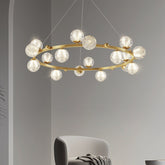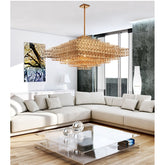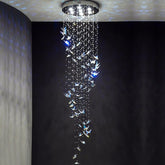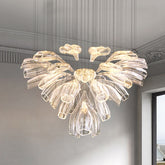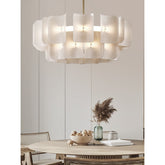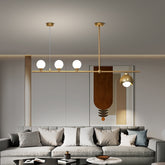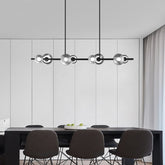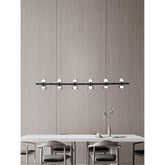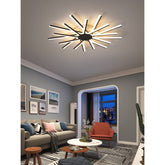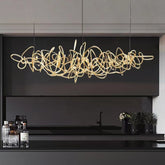Designing Your Home to Sync with Your Natural Body Clock - Connection of Chronobiology and Lighting
In our fast-paced modern world, maintaining a healthy balance between work, relaxation, and sleep can be challenging. However, an often overlooked but essential aspect of well-being lies in how well our daily routines align with our natural body clock, a field of study known as chronobiology. Chronobiology explores the rhythms that govern our physical, mental, and emotional states, ensuring that our body’s internal clock stays in sync with the external environment.
Lighting, both natural and artificial, plays a pivotal role in this delicate balance. The type, intensity, and timing of light exposure can either support or disrupt our circadian rhythms. Natural light, particularly in the morning, helps set our internal clocks, while the wrong type of artificial lighting in the evening can throw us off balance, leading to sleep disturbances and other health issues. Therefore, designing your home with chronobiology in mind—particularly through thoughtful lighting choices—can be a transformative step toward a healthier, more harmonious lifestyle.
Understanding Chronobiology
Chronobiology is the scientific study of the natural physiological rhythms that regulate our bodies. These rhythms, known as biological clocks, are influenced by environmental cues such as light, temperature, and social activities. The most prominent of these cycles is the circadian rhythm, a roughly 24-hour cycle that dictates various bodily functions, including sleep-wake patterns, hormone production, and even cell regeneration. Chronobiology helps us understand how these rhythms influence our health and well-being, providing insights into how we can optimize our daily routines to align with our natural body clock.
The Circadian Rhythm
The circadian rhythm is the cornerstone of chronobiology, acting as an internal timekeeper that governs when we feel alert, sleepy, hungry, or energized. This rhythm is primarily influenced by light exposure, with natural daylight serving as the most powerful cue. In the morning, exposure to bright light signals to our brain that it’s time to wake up, triggering the release of cortisol, a hormone that boosts alertness and energy. Conversely, as evening approaches and light levels decrease, the brain begins producing melatonin, a hormone that promotes relaxation and sleep.
Impact of Disruption
Disruptions to the circadian rhythm can have significant consequences for both short-term and long-term health. Exposure to artificial light at night, especially blue light emitted from screens, can trick the brain into thinking it’s still daytime, suppressing melatonin production and delaying sleep. This can result in difficulty falling asleep, poor sleep quality, and a misalignment of the body’s internal clock.
Over time, chronic circadian disruption has been linked to more serious health problems, including obesity, diabetes, cardiovascular disease, and mental health disorders such as depression and anxiety. Understanding the importance of maintaining a regular sleep-wake schedule and minimizing exposure to disruptive light sources is crucial for preserving the integrity of the circadian rhythm and supporting overall health.
The Role of Natural and Artificial Lighting
Natural Lighting
Natural lighting is one of the most powerful tools for regulating your body’s internal clock, also known as the circadian rhythm. Exposure to natural light, especially during the early hours of the day, has profound benefits for your physical and mental well-being. Morning sunlight is rich in blue wavelengths, which signal to your brain that it’s time to wake up, increase alertness, and boost mood-enhancing hormones like serotonin. By incorporating ample windows, skylights, and open spaces in your home design, you can maximize the amount of natural light you receive, helping to keep your circadian rhythm in sync with the natural day-night cycle.
The benefits of natural light extend beyond just regulating sleep. Studies have shown that consistent exposure to daylight can improve mood, reduce stress, and enhance productivity. In work-from-home environments, positioning your workspace near a window can make a significant difference in your energy levels and focus. Even brief periods of sunlight exposure throughout the day can help stabilize your body clock, leading to better sleep at night and a more balanced daily rhythm.
Artificial Lighting
While natural light is ideal, artificial lighting plays a crucial role in maintaining your circadian rhythm, especially in the evening or during seasons with limited daylight. However, not all artificial light is created equal. The type, intensity, and timing of artificial lighting can either support or disrupt your natural rhythms.
Bright, cool-toned lights are beneficial during the day as they mimic natural daylight, promoting wakefulness and concentration. However, in the evening, exposure to these types of lights—particularly those that emit blue wavelengths—can interfere with your body’s ability to produce melatonin, the hormone responsible for sleep. To prevent this, it’s important to use warm, dim lighting during the evening hours. Soft, amber-colored lights can create a relaxing atmosphere that signals to your body it’s time to wind down, facilitating a smoother transition to sleep.
Color Temperature and Lighting
Color temperature, measured in Kelvin (K), is a key factor in how lighting affects your perception of time and your sleep-wake cycles. Higher color temperatures (5000K-6500K) produce a cool, blueish light similar to daylight, which is ideal for morning and afternoon use when you need to stay alert and energized. Lower color temperatures (2000K-3000K) emit a warm, yellowish light, which is more conducive to relaxation and should be used in the evening to help prepare your body for sleep.
Understanding the impact of color temperature can help you make more informed decisions about the lighting in your home. During the day, aim to use lighting that replicates the brightness and color of natural sunlight. In contrast, evening lighting should be softer and warmer, helping to ease the transition from daytime activity to nighttime rest.
Designing Your Home to Sync with Your Natural Body Clock
Creating a home environment that supports your natural body clock begins with thoughtful lighting design. To align with the body’s circadian rhythm, it’s essential to consider both the placement and type of lighting used in each room. Incorporating natural light sources, such as large windows and skylights, can significantly impact your well-being by keeping your circadian rhythm in sync with the natural day-night cycle. When natural light is insufficient, especially in the darker months, artificial lighting should mimic the natural progression of daylight. Opt for adjustable lighting solutions that allow you to control brightness and color temperature throughout the day, ensuring your home environment supports your body’s needs at different times.
Morning Light Exposure
Maximizing exposure to natural light in the morning is crucial for kickstarting your circadian rhythm. Morning sunlight is rich in blue light, which helps signal to your brain that it’s time to wake up and be alert. Positioning your breakfast nook or home office near a window where you can soak up the morning sun is a great way to naturally boost your energy levels. If natural light isn’t readily available, consider using bright, cool-toned artificial lights during the morning hours. Light therapy lamps, which simulate natural sunlight, can be particularly effective during the winter months when daylight is limited.
Evening Lighting Solutions
As evening approaches, it’s essential to transition to warmer, dimmer lighting to prepare your body for rest. Evening light should minimize blue light exposure, which can suppress melatonin production and delay sleep onset. Consider using dimmable lamps with warm-colored bulbs in your living spaces and bedrooms. Installing amber-tinted light bulbs or using smart lighting systems that automatically adjust the color temperature as the day progresses can create a soothing, sleep-friendly environment. Additionally, minimizing the use of screens or employing blue light filters on devices during the evening hours can further protect your circadian rhythm.
Smart Lighting Systems
Smart lighting technologies offer an innovative solution to synchronizing your home’s lighting with your natural body clock. These systems can be programmed to adjust the intensity and color temperature of your lights throughout the day, mirroring the natural changes in sunlight. For instance, smart lights can gradually brighten in the morning, mimicking a sunrise to help you wake up naturally, and then shift to a warm, dim glow in the evening to promote relaxation. Some advanced systems even use sensors to track your daily routines, automatically adjusting the lighting to support your circadian rhythm.
Room-by-Room Lighting Guide
Bedroom
The bedroom is your sanctuary for rest, and the lighting should reflect that. To create a sleep-friendly environment, focus on lighting that promotes relaxation and supports your natural sleep-wake cycle. Use warm, dimmable lights with a color temperature between 2000K and 3000K to mimic the calming hues of sunset, helping your body prepare for sleep. Bedside lamps with soft, amber-colored bulbs or adjustable lighting that gradually dims as bedtime approaches can be especially effective. Avoid harsh overhead lighting in the evening, as it can be too stimulating. Consider blackout curtains to block out any external light that might disrupt your sleep. Smart lighting systems that gradually brighten in the morning, simulating a natural sunrise, can help you wake up more naturally and start your day feeling refreshed.
Living Room
The living room is a multifunctional space where you relax, entertain, and spend quality time with family. To balance comfort and functionality, use a combination of ambient, task, and accent lighting. During the day, take advantage of natural light by keeping window treatments light and airy. For evening use, opt for warm, layered lighting that can be adjusted based on your activities. Dimmable overhead lights, combined with floor lamps and wall sconces, can create a cozy atmosphere while allowing you to control the brightness. If you enjoy reading or watching TV in the living room, ensure that task lighting is positioned to reduce eye strain while still maintaining a relaxed ambiance. Consider using smart bulbs that can transition from bright daylight tones to warm, evening hues to keep your circadian rhythm in sync.
Home Office
In the home office, productivity is key, and lighting plays a significant role in keeping you focused and energized. Position your desk near a window to maximize natural light exposure, which can boost alertness and concentration. If natural light is limited, use bright, cool-toned artificial lighting with a color temperature of around 5000K to 6500K, which mimics daylight and helps maintain high energy levels throughout the day. Desk lamps with adjustable brightness and direction are ideal for reducing glare on your computer screen while providing targeted lighting for detailed tasks. As the day progresses, gradually shift to warmer, softer lighting to signal to your body that it’s time to wind down, helping to maintain a healthy work-life balance.
Bathroom
The bathroom is where you start and end your day, making it essential to have lighting that adapts to both morning energization and evening relaxation. In the morning, bright, cool-toned lighting can help wake you up and prepare you for the day. Overhead lights with a color temperature of 4000K to 5000K work well for this purpose, providing ample illumination for tasks like shaving or applying makeup. In the evening, switch to warmer, dimmer lighting to create a spa-like atmosphere that encourages relaxation. Installing dimmable lights around the vanity mirror and adding soft, ambient lighting near the bathtub can help transition your body from the busyness of the day to a state of calm, making it easier to unwind before bed.
Final Words
Designing a home that syncs with your natural body clock is more than just an aesthetic choice; it’s a powerful way to enhance your life. From optimizing natural and artificial lighting to considering room-specific lighting needs, every aspect of your home environment can contribute to better sleep, improved mood, and increased productivity.
If you’re looking to improve your quality of life, now is the perfect time to assess your home’s lighting and make adjustments that support your body’s natural rhythms. Simple changes, like increasing morning light exposure or switching to warmer evening lighting, can have a profound impact on how you feel and function every day.
For those interested in taking their home lighting to the next level, consider exploring smart lighting solutions that adapt to your schedule or consult with a professional lighting designer for a personalized plan. By making these changes, you can create a living space that truly supports your health, helping you live in harmony with your natural body clock.












































































































